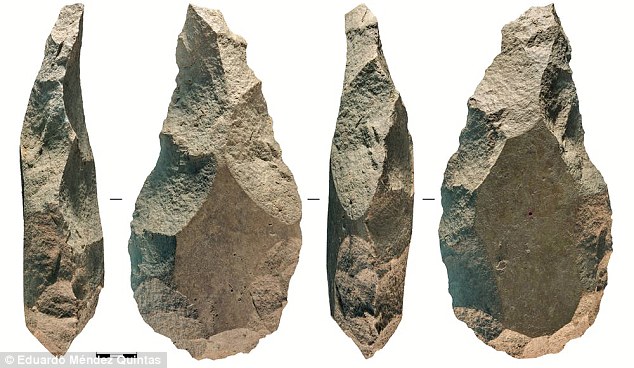Giant handaxes that are between 200,000 to 300,000 years old would have been used by mystery ancestors to cut up prey in prehistoric Europe, research suggests.
Laboratory analyses indicate that the giant tools, found at Porto Maior, northwest Spain, were used to process hard materials such wood and carcasses.
While these tools were being used in one area, a different stone tradition (Early Middle Palaeolithic) was present in Iberia.
Scientists believe this reinforces the idea human groups from different origins and evolutionary stages coexisted when Neanderthals first started to emerge.
Researchers say that although they are double the size of most handaxes the Neanderthals or near modern human sapiens species that used them would have been no larger than humans today.
The archaeological site at Porto Maior is home to these ancient tools which were part of the Acheulean culture.
‘This is an interesting time in human evolution’, Dr Chris Lepre, a researcher at Lamont-Doherty and teaching professor at Rutgers University told MailOnline.
‘Broadly speaking these tools would have been used by something called ‘archaic homo sapiens’. That may be a Neanderthal or a close almost near modern human sapiens species.
‘There is evidence these species are coexisting in this area at the time’, he said.
Tools from the Acheulean cuture are characterised by symmetrically knapped stones and are the first sophisticated handaxe technology known in early Europe.
While Acheulean sites are widespread across the continent, Porto Maior represents Europe’s first extensive accumulation of large cutting tools (LCTs) in the Acheulean tradition.
‘This is just another bit of evidence that shows some of these advanced behaviours such as making large handaxes are not something exclusive to one species’, said Dr Lepre.
‘Our predecessors were capable of a wider range of behaviours than previously thought’, he said.
Until now, such high densities of LCTs had only been found in Africa.
‘Porto Maior introduces further complexity to this overlapping technological pattern, and suggests that distinct early human populations of different geographical origins coexisted during the Middle Pleistocene (between 773,000 and 125,000 years ago)’, researchers, led by Dr Martina Demuro, a research fellow at the University of Adelaide wrote in the Conversation.

In total, 3,698 discarded artefacts were recovered from river sediments at the site, 101 of which were LCTs that were on average 18cm long with a maximum length of 27cm.
This is exceptionally large considering most handazes are typically 8-15cm long.
‘Conventional interpretation of such large handaxes usually focuses on the idea that they were used for ceremonial purposes’, Dr Lepre said.
‘Normally when we see exceptionally large tools they are not use for digging or processing food. They are symbolic.
However, Dr Lepre dismissed the idea that these giant tools could have belonged to larger people.

‘There’s not much evolution of the human body going on since then – most of what you see today was present back then. Our size and statue has not changed’.
At 9.5 pieces per m², the density of the Acheulean stone tool accumulation is one of the highest recorded globally.
‘The Spanish site of Porto Maior clearly resembles extensive accumulations of very large tools previously only seen in Africa and the Near East’, researchers wrote.
‘These similarities reinforce the idea of an African origin for the Acheulean tradition of southwest Europe.’
Researchers used post-infrared infrared stimulaed luminescence dating and electron spin resonance to date the tools.
This technique provided researchers with an estimate of the last time sand grains in the sedient was exposed to sunlight.
This gives an idea of when the site was last occupied.
‘The specific type of Acheulean tools described at Porto Maior is exclusive to southwest Europe, suggesting that the technology was brought into the region by an ‘intrusive’ population’, researchers wrote.
‘The age of Porto Maior is consistent with previous findings from Iberia that suggest that the Acheulean culture experienced an expansion in the region between 400,000 to 200,000 years ago.’
‘While it is clear that more human fossil and stone tool sites need to be reliably dated across the region, a picture appears to be emerging of a turbulent ‘Game of Thrones’ style scenario of hominin evolution in Eurasia during the Middle Pleistocene period’, researchers wrote.













